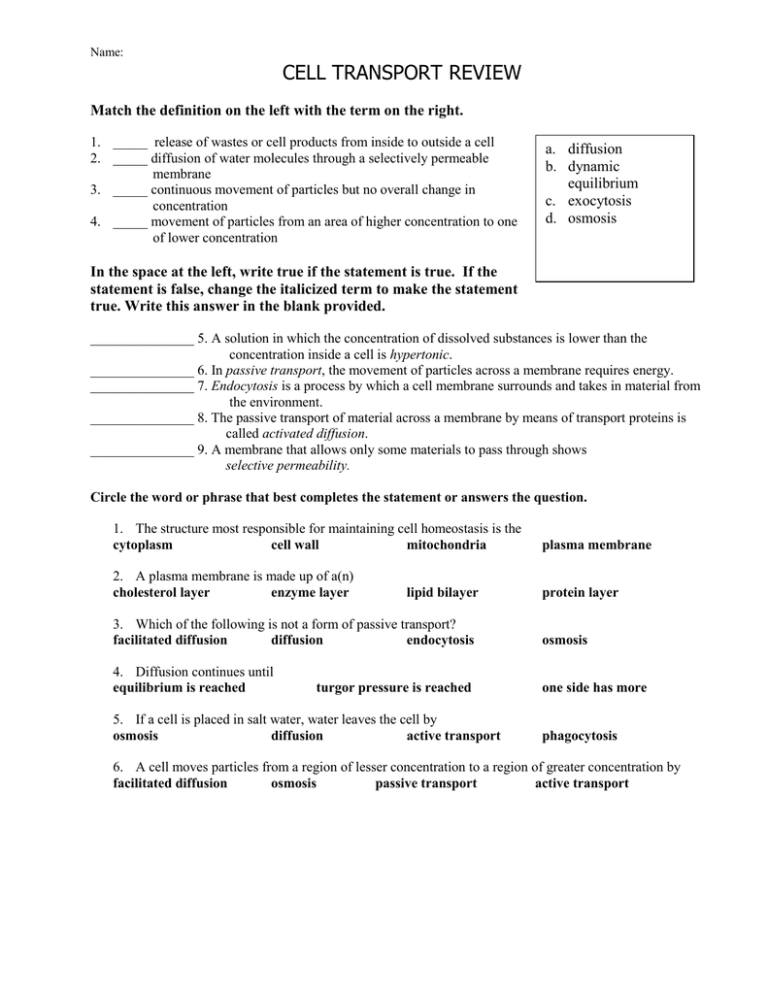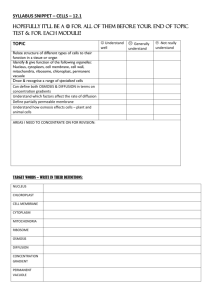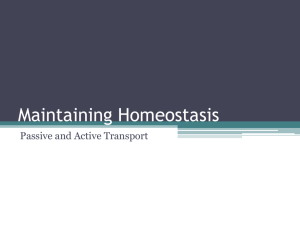Cell Transport Review
advertisement

Name: CELL TRANSPORT REVIEW Match the definition on the left with the term on the right. 1. _____ release of wastes or cell products from inside to outside a cell 2. _____ diffusion of water molecules through a selectively permeable membrane 3. _____ continuous movement of particles but no overall change in concentration 4. _____ movement of particles from an area of higher concentration to one of lower concentration a. diffusion b. dynamic equilibrium c. exocytosis d. osmosis In the space at the left, write true if the statement is true. If the statement is false, change the italicized term to make the statement true. Write this answer in the blank provided. _______________ 5. A solution in which the concentration of dissolved substances is lower than the concentration inside a cell is hypertonic. _______________ 6. In passive transport, the movement of particles across a membrane requires energy. _______________ 7. Endocytosis is a process by which a cell membrane surrounds and takes in material from the environment. _______________ 8. The passive transport of material across a membrane by means of transport proteins is called activated diffusion. _______________ 9. A membrane that allows only some materials to pass through shows selective permeability. Circle the word or phrase that best completes the statement or answers the question. 1. The structure most responsible for maintaining cell homeostasis is the cytoplasm cell wall mitochondria plasma membrane 2. A plasma membrane is made up of a(n) cholesterol layer enzyme layer protein layer lipid bilayer 3. Which of the following is not a form of passive transport? facilitated diffusion diffusion endocytosis osmosis 4. Diffusion continues until equilibrium is reached one side has more turgor pressure is reached 5. If a cell is placed in salt water, water leaves the cell by osmosis diffusion active transport phagocytosis 6. A cell moves particles from a region of lesser concentration to a region of greater concentration by facilitated diffusion osmosis passive transport active transport Use the pictures on the left to answer the questions on the right. 1. After digestion: a. Which side has the higher concentration of glucose? ________ b. Which way will the glucose go? ________________________ c. Does this require energy? ___________ d. Is this active or passive transport? _______________________ e. What specific type of transport is this? ___________________ = glucose molecule blood cell 2. Easter egg coloring: A blue food coloring tablet is placed in a cup of vinegar and water. The blue tablet will dissolve and spread evenly throughout the liquid. beaker Water and vinegar a. Is this active or passive transport? ___________________ b. Is this diffusion or osmosis? _______________________ c. Does this require energy? _________________________ d. Is the blue die going from a lower to a higher concentration, or from a higher to a lower concentration? ______________ Blue food color tablet 3. Plant cell after being over-watered. a. Water rushes into the plant cell’s vacuole. Is this diffusion or osmosis? _________________________ b. Is this passive or active transport? _____________________ c. Is the plant cell in a hypertonic, hypotonic, or isotonic environment? _________________________________ 4. Plant cell after not being watered lately, so it has begun to wilt: a. Which way will the water go? Into the vacuole, or out of the vacuole? ______________________ b. By what process will the water move? c. Is the plant cell in a hypertonic, hypotonic, or isotonic environment? _____________________________ 5. An amoeba engulfs a particle of food. a. Does this require energy?_______________________ b. Is this active or passive transport? __________________ c. Is this endocytosis or exocytosis? __________________ 5. An amoeba expels waste. a. Does this require energy?_______________________ b. Is this active or passive transport? __________________ c. Is this endocytosis or exocytosis? __________________ 6. A cell surrounded by blood: a. Will water move from the blood to the cell, or from the cell to the blood? ________________________ b. Which has the higher concentration of water, the cell or the blood? __________________ c. Does this require energy? ______________________ d. Is this active or passive transport? __________________ e. Is this diffusion or osmosis? _______________________



